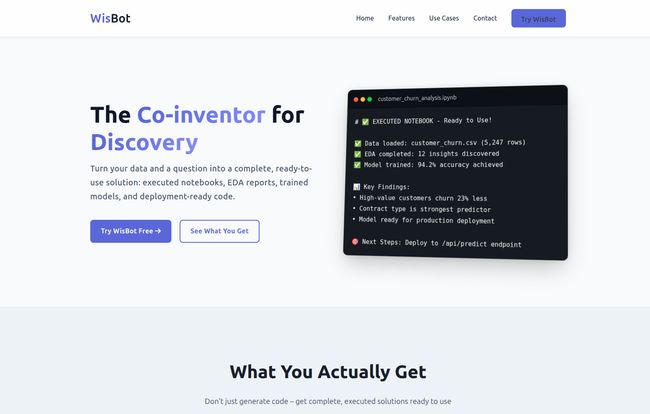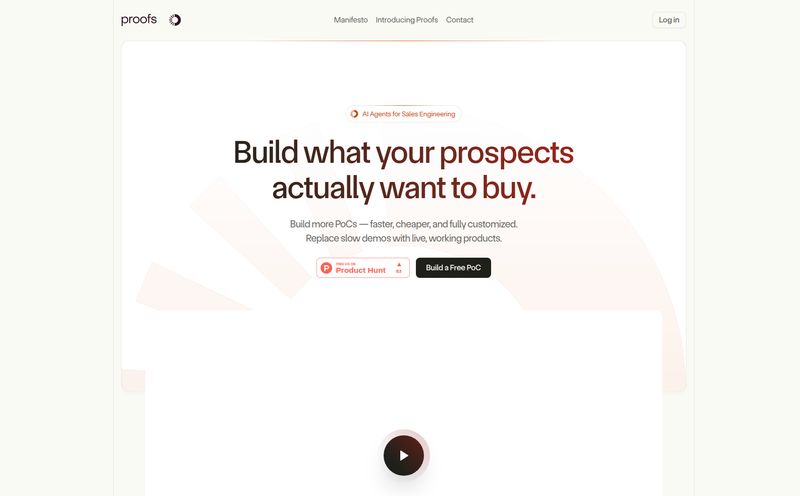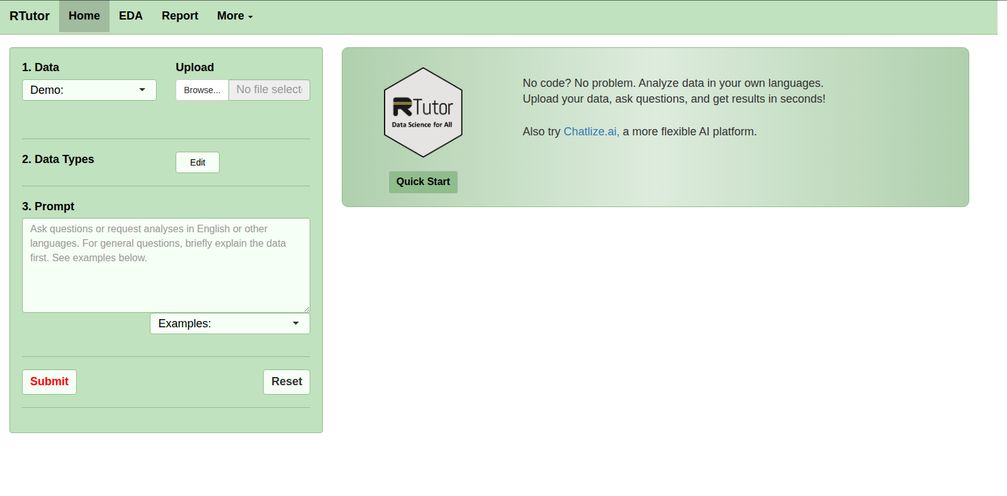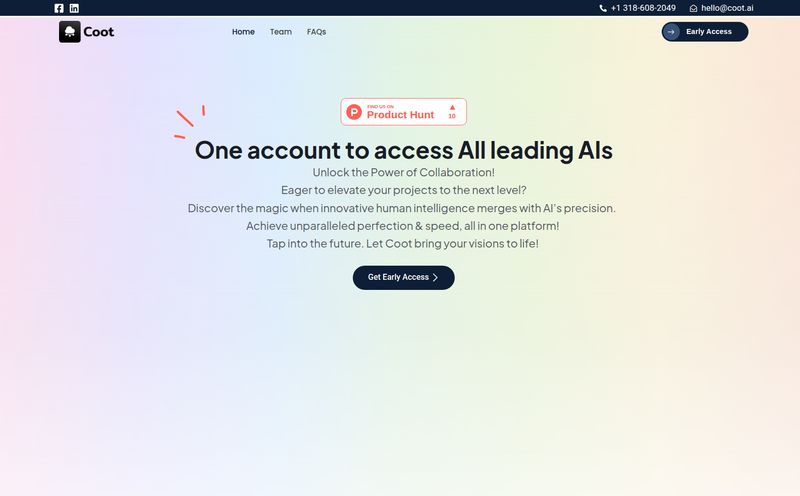The AI hype train is moving at a thousand miles an hour, and it feels like every week there's a new "game-changing" AI assistant that promises to write your emails, plan your vacation, and walk your dog. Most of them are... fine. They’re usually thin wrappers around a big language model, and they’re great for general tasks. But what about the really tough stuff? The niche, complex work that requires domain expertise?
I’m talking about data science. As someone who's spent more hours than I care to admit wrestling with pandas DataFrames and staring at broken Matplotlib charts at 2 AM, I've been both hopeful and deeply skeptical about AI's role in the field. I’ve seen enough half-baked code snippets from general AIs to know they don't quite get the full picture. So, when I stumbled upon a tool called WisBot that calls itself "The co-inventor for Data Science," my curiosity was definitely piqued.
It’s not just promising to write a function for you. It’s promising to take your raw data and turn it into a full-blown, ready-to-run Jupyter Notebook with analysis, models, and all. That’s a bold claim. So, I decided to take a closer look and see if it’s the real deal or just more AI snake oil.
So, What Exactly Is WisBot Claiming to Do?
Right off the bat, WisBot positions itself differently. It’s not a generalist. Its entire reason for being is to serve data scientists and machine learning engineers. The homepage cuts right to the chase with a simple, three-step promise: Upload & Describe, AI Executes Everything, and Download Ready Results. Simple enough.
This isn't about asking an AI to "write a Python script to clean a CSV." It's about giving it the CSV file and saying, "Here's my data on customer churn. I need you to perform an exploratory data analysis, identify key drivers of churn, and build a predictive model." WisBot then goes off and, supposedly, does the heavy lifting, delivering a complete project. It’s the difference between asking for a bag of groceries and asking for a fully cooked, three-course meal. A very, very important difference for anyone on a deadline.

Visit WisBot
Beyond Snippets: The Promise of Run-Ready Results
I think the most compelling part of WisBot's pitch is the distinction it draws between itself and what it calls "Regular Code Generators." We've all used them. They're great for boilerplate or figuring out some obscure library syntax. But you're still the one putting all the pieces together. WisBot aims to be the architect, not just the bricklayer.
Generating Complete Jupyter Notebooks
Setting up a new project in Jupyter is a ritual. You import numpy as np, import pandas as pd... you load the data, you run `.head()`, `.info()`, `.describe()`. It's a necessary but tedious dance. WisBot’s promise is to automate that entire initial phase. It generates the code, the visualizations, and even the explanatory text (in Markdown) that makes a notebook readable and presentable. This alone could be a massive timesaver, especially for repetitive analytical tasks.
Not Just Code, But Production-Ready Projects
Here's where my skepticism meter starts to twitch a little. "Production-ready" is a heavy term. WisBot claims it can generate a complete Python project with data, models, and deployment scripts. If true, this moves it from a handy utility to an actual workflow accelerator. It suggests it can handle creating end-to-end model training pipelines, which is often the most complex and time-consuming part of an ML project.
Real-World Scenarios Where This Could Be a Lifesaver
Let's ground this in reality. Where would a tool like this actually fit in my day-to-day? The website lays out a few scenarios that hit pretty close to home.
- Tight Deadline Analysis: The classic. Your boss drops a dataset on you at 4 PM and needs insights for a 9 AM meeting. Instead of a frantic, caffeine-fueled night of coding, you could theoretically offload the initial EDA and modeling to WisBot, leaving you to focus on interpreting the results and building the narrative.
- Rapid Prototyping: You have a hunch or a new idea for a model. Setting up the entire experiment can be a drag, so much so that sometimes we dont even bother. Using WisBot to quickly spin up a baseline model and initial analysis could make experimentation much more fluid.
- Client Presentations: This one is huge. Being able to quickly generate a clean, well-documented notebook with visualizations is perfect for showing clients or stakeholders what the data is saying without spending half your time on formatting and cleanup.
- MVP to Production: The site claims it can help you "skip months of infrastructure setup." I'm going to take that with a grain of salt. It's unlikely to replace a dedicated MLOps engineer, but if it can generate the foundational pipeline—the data ingestion, preprocessing, training, and validation scripts—it has already done a massive amount of work. It builds the skeleton, you just need to add the muscle.
The Good, The Bad, and The "We'll See"
No tool is perfect, especially in the fast-moving world of AI. After digging through their site and thinking about its place in the modern data science stack, here's my breakdown.
The Upside is Obvious
The main advantage is speed. It's all about automating the repetitive, time-consuming grunt work that bogs down the start of any data project. For a solo data scientist or a small, scrappy team, this could be a force multiplier. I also believe it could be a fantastic learning tool. A junior data scientist could use it to see how a professional, end-to-end project is structured, learning best practices from the generated output.
The Potential Hiccups and Questions
First, the classic AI problem: garbage in, garbage out. WisBot’s intelligence depends entirely on the quality of your data and the clarity of your instructions. A vague prompt will likely lead to a vague and unhelpful notebook. You still need to be a good data scientist to ask the right questions.
Second, there's the question of the learning curve. The site itself says it's for data scientists and ML engineers, which implies you need to know what you're doing. This isn't a magic button for someone who has never heard of a random forest. It's a power tool for the professional, not a replacement for one.
And finally, the elephant in the room: What about the price? As of my writing this, the website has a "Try WisBot Free" button but no public pricing page. This usually means a custom, enterprise-focused plan or a tiered subscription model is in the works. The lack of transparent pricing can be a bit of a hurdle for individuals or small businesses who just want to know what they're getting into.
Frequently Asked Questions about WisBot
Is WisBot just for Python?
Yes, it appears to be entirely focused on the Python data science ecosystem, specifically generating code for and within Jupyter Notebooks.
Can WisBot replace a human data scientist?
Not a chance. Think of it as a very skilled junior assistant or a co-pilot. It handles the routine tasks, freeing up the human expert to focus on complex problem-solving, interpretation, and strategic thinking. It automates tasks, not intuition.
Do I need to know how to code to use WisBot?
You'll get a lot more out of it if you do. To give it good instructions and to validate (and potentially tweak) the output, a foundational understanding of data science concepts and Python is pretty much required.
What makes WisBot different from ChatGPT or GitHub Copilot?
Specialization. ChatGPT and Copilot are general-purpose code assistants that provide snippets and suggestions. WisBot is a workflow automation tool designed to manage an entire data science project from data input to a final, validated model and report.
How does WisBot handle data privacy?
This is a critical question for any tool that requires you to upload your data. You would need to check their specific Privacy Policy and Terms of Service to understand how your data is stored, used, and protected. I would be cautious with highly sensitive data on any new cloud platform.
Is WisBot free?
There is a free trial option available on their website. However, they do not list public pricing tiers, which suggests that long-term use will likely involve a paid subscription or custom plan.
My Final Take
So, is WisBot the future? It’s definitely pointing in the right direction. It's not a magical AI that will make data scientists obsolete. Instead, it’s a highly specialized power tool designed to sand down the roughest, most time-consuming edges of the job. It's an admission that a huge part of data science is repetitive setup and boilerplate, and that's a perfect job for a machine.
To use a metaphor, WisBot isn’t a self-driving car that takes you from A to B while you nap. It's more like the most advanced driver-assist system you've ever seen. It handles the boring highway miles of data cleaning and EDA, keeps you in your lane with best practices, and builds a solid baseline model, but you—the driver—still need to be paying attention, ready to take the wheel for the tricky turns and to decide on the final destination.
For teams looking to move faster and individuals wanting to spend less time on setup and more time on actual analysis, WisBot is absolutely a tool to watch. I’m genuinely excited to see how it evolves. It might just be the co-inventor we've been looking for.
Reference and Sources
- WisBot Official Website
- "The Next Era of Data Science: AI-Assisted Workflows" - Towards Data Science (Note: This is a representative article on the topic, not a direct source from the post).



